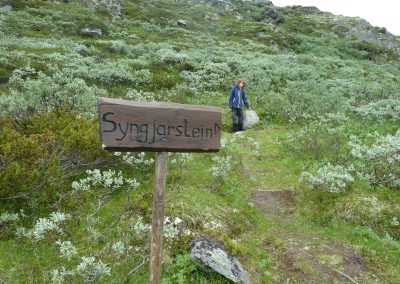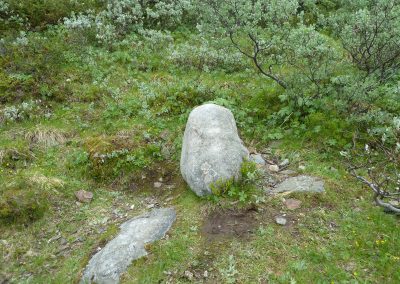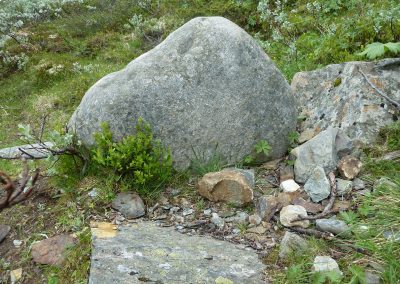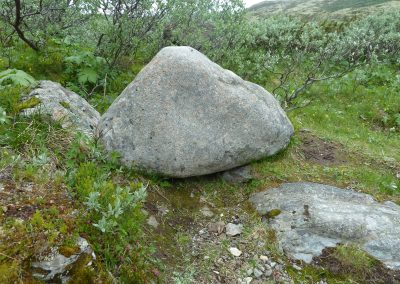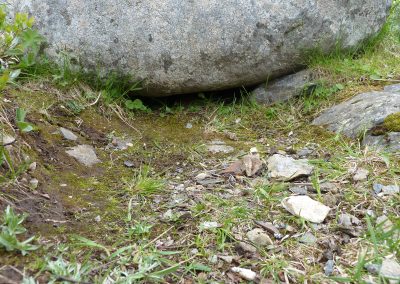The Singing Stone by Råtåsjøen
Type: Ringing stone
Local name: Syngjarsteinen
Locality
County: Innlandet
Municipality: Folldal
Location: Råtåvasskaret, north of lake Råtåsjøen
The stone is located on the alpine mountain along the road from Dalholen to Einunndalen. At Dalholen turn off by the sign for Einunndalen, and follow Furuhovdvegen and Sætervegen north to lake Råtåsjøen, situated on the left after some 11 kilometres. 780 meters from the north end of the lake, there is a sign «Syngjarstein» on the east side of the road. The stone is placed just a few meters from the road (1174 m.a.s.l.).
Description
This is a fairly small stone, with a rounded triangular shape. Height 70 cm, length 95 cm, thickness 30–40 cm. The stone is standing upright, with some space underneath. It looks like it was placed intentionally in this way. Several smaller stones lie around, as a sign that people have played on the stone and thrown away the stones they have used. The pitch is high, with slightly lower frequencies on the sides and the highest on top. The stone lies within the boundaries of the Flåman nature reserve, established in 1989 with the aim of preserving a landscape with important Quaternary geological form elements.
Cultural history and tradition
Syngjarstein (The Singing Stone) is well known in Folldal, and is part of the cultural heritage plan of Folldal Municipality.
The stone was previously located by the old road, but was moved down to the new car road when it was built. It is said that the stone sounded better in its original location. In 1999, the sign “Syngjarstein” was placed by the road. It was provided by Folldal Mållag, in collaboration with Leif Løchen from Nord-Gudbrandsdal Folk Music Archive, as part of his registrations of old folk instruments.
In an article in Folldalsjul, Kirstine Prestmoen Tallerås tells about the stone, and writes that the milk truck often stopped by the singing stone. In the 1950s, the milk truck functioned as a regular bus and carried passengers: “On Saturday evenings, it always brought many passengers who were going to visit the summer pastures for the weekend. Monday morning they returned to the village. If Per Borkhus joined, he used to order a stop at the Syngjarstein. Then all the kids had to get out of the car and try the sound”.
A record made by Leif Løchen was that the aforementioned Per Borkus used to hit the singing stone with a hard small stone he found on the side of the road—while whistling besides. Løchen also noted down a retelling from a man who believed that the stone sang the national anthem “Ja, vi elsker”. A perhaps less humorous account was one telling that his father, who was born in the 1880s, knew the location of the stone, but that he was afraid to show it to others—for unknown reasons. The singing stone has been spoken of with respect, perhaps a remnant from a time when the sound from it had a magical, perhaps also a religious meaning.
NB: The sound quality of the recordings (from 2007) unfortunately does not do justice to the singing stone. The recordings sound best with headphones.
Kilder: Leif Løchens records; Utvalgte kulturminner i Folldal kommune, Kommunedelplan for kulturminner og kulturmiljøer i Folldal 2002–2025 (Selected cultural monuments and sites in Folldal municipality), p. 172; Kirstine Prestmoen Tallerås: «Syngjarstein», in Folldalsjul 2006, p. 50.
Thanks to Ann-Turi Ford and Jo Kolltveit.
